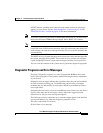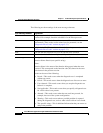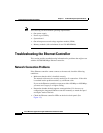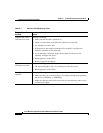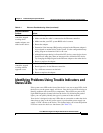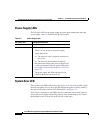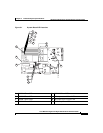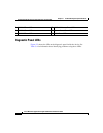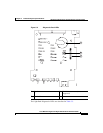
5-15
Cisco Wide Area Application Engine 7326 Hardware Installation Guide
OL-6831-02
Chapter 5 Troubleshooting the System Hardware
Identifying Problems Using Trouble Indicators and Status LEDs
Identifying Problems Using Trouble Indicators and
Status LEDs
If the system error LED on the front of the device is on, one or more LEDs inside
the device or on the power supply will be on. Your device has LEDs to help you
identify problems with some device components. These LEDs are part of the
Light Path Diagnostics feature built into the device. By following the path of
lights, you can quickly identify the type of system error that occurred.
Your device is designed so that any LEDs that are on remain on when the device
shuts down as long as the AC power source is good and the power supply can
supply +5 VDC current to the device. This feature helps you isolate the problem
if an error causes the device to shut down. (See Table 5-4.)
The Ethernet
controller stopped
working when
another adapter was
added to the device.
Check the following:
• Make sure that the cable is connected to the Ethernet controller.
• Make sure that your PCI system BIOS code is current.
• Reseat the adapter.
• Determine if the interrupt (IRQ) setting assigned to the Ethernet adapter is
also assigned to another device in the system. Use the configuration/setup
utility program to determine if this is the case.
• Although interrupt sharing is allowed for PCI devices, some devices do not
function well when they share an interrupt with a dissimilar PCI device.
Try changing the IRQ assigned to the Ethernet adapter or the other device.
• Reseat or replace the adapter.
The Ethernet
controller stopped
working without
apparent cause.
Check the following:
• Run diagnostics for the Ethernet controller.
• Try a different connector on the hub.
• Reseat or replace the adapter.
Table 5-1 Ethernet Troubleshooting Chart (continued)
Ethernet Controller
Problem Actions



